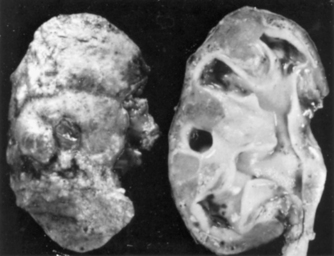74. Pyelonephritis
Definition
Pyelonephritis is a potentially organ-threatening, fatal inflammation of the kidney and renal pelvis secondary to a bacterial infection that begins in the interstitial tissues and rapidly extends to involve the renal tubules and glomeruli, culminating in the renal blood vessels.
Incidence
Approximately 250,000 cases of pyeolonephritis occur each year in the United States. About 192,000 of these cases require hospitalization. There have been no discernable racial or ethnic predilections, but females strongly outnumber males.
Etiology
The root cause of pyelonephritis is bacterial infection/invasion of the kidney parenchyma (see box below). Finding the cause of pyelonephritis requires determining the following: (1) which pathogens are typically cultured and their frequency; (2) whether the urinary tract infection is complicated; and (3) which pathogenic organism is involved in the complicated urinary tract infection. A complicated urinary tract infection (UTI) is defined as one occurring along with an additional factor that reduces the efficacy of antimicrobial therapy and leads to therapy failure, relapses, or persistence of infection.
Causative Organisms in Pyelonephritis
• Citrobacter species
• Coagulase-negative Staphylococci
• Enterobacter species
• Enterococci
• Escherichia coli
• Group B Streptococci
• Klebsiella species
• Proteus mirabilis
• Pseudomonas aeruginosa
• Staphylococcus aureus
 |
| Pyelonephritis. Chronic pyelonephritis. The surface (left) is irregularly scarred. The cut section (right) reveals characteristic dilation and blunting of calyces. |
Signs and Symptoms
• Anorexia
• Chills
• Fever (sometimes)
• Malaise
• Mild-to-moderate or severe pain
• Nausea
• Rigor
• Tachycardia
• Unilateral or bilateral flank pain
Buy Membership for Anesthesiology Category to continue reading. Learn more here







